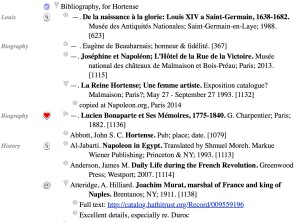I’m at sixes and sevens today (a soon to be Mother-of-the-Bride, so understandable). Even my 100-word writing minimum is a challenge. At such times, I turn to organizing research. It’s important to do, and it doesn’t require creative energy.
Organizing research: recording citation information
My system for organizing research texts is simple. I keep the list of all books or magazine articles in a Notebook application, but any outlining program would do. Each book or magazine is assigned a number (I’m up to 1148, yikes), which I write in pencil in the book or on a post-it note which I stick on the inside front cover.
The application Notebook makes it possible for me to annotate the listings and add “stickers.” The double S sign shown here means that the book is in my library in Canada. I have stickers to indicate books that are in Mexico, books that go back and forth, library books and books that are on-line. For the on-line listings I will include a link in the citation.
Organizing research: organizing the bibliography
Then I moved the citation into the list of books I’m using for the WIP — the novel about Josephine’s daughter Hortense in this instance, and Notebook automatically alphabetizes them.
Organizing research: taking notes
And then the hard part: reading the texts and taking notes. Each reference I make to the book or magazine I reference with the text’s number, and page number:
[1145-58]
That way I can track back to the source, should I need to later.
See also:
For more on my research process and research in general, go to On Research, and specifically, My Research Method.
How do you organize your research?




